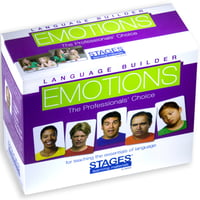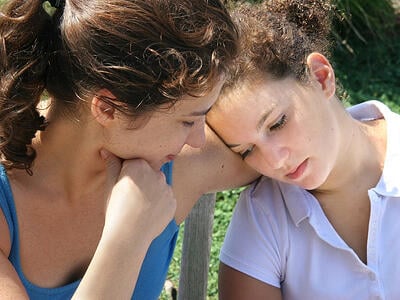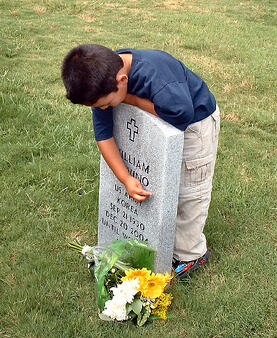Grief and Loss: Helping Children with Autism Cope
 Download FREE Language Builder Emotion Cards!
Download FREE Language Builder Emotion Cards!People who have autism tend to be very routine-oriented, and benefit from advance preparation for any changes that may happen to disrupt their normal routines. Obviously the death of someone close interferes not only with daily routines, but can also elicit unexpected emotions or behaviors from children and adults alike.
Since death is an uncomfortable topic of conversation for many people, parents and teachers of children with ASD may avoid talking about it until the unfortunate loss of a loved one occurs. But because people with autism benefit greatly when they understand what to expect in a given situation, time frame, or social interaction, they can be justifiably thrown off by a sudden or unknown situation such as the death of a family member. If they haven’t previously had any instruction or discussion about what to expect when someone dies, this already challenging time can be made that much more difficult to manage.
Family members and caregivers of children with autism understandably want to help their child comprehend what is happening both when anticipating and after the death of a loved one. Below are some ideas about how to help kids with autism understand and cope with death and bereavement.
Talking and teaching about death before a loss occurs can be beneficial for children with autism. This allows them time to ask questions and process information without the emotions and events related to an actual death. Death is a normal, and inevitable, part of life, and talking about it can make it seem less taboo and less scary for a child with autism.

When it is appropriate, talk about death as it occurs in everyday life. For example, discuss the dead housefly you found in the window or a famous person whose death you heard about on the news. Similarly, if someone in the family is sick, talk about that illness with your child. Talking about Grandpa’s visits to the hospital and what they mean about his overall health now can help your child to better comprehend his eventual passing later.
When talking about death, make the concept as concrete as possible. Discuss what it means physically for someone or something to die. When looking at the housefly in the window, talk about how it can’t fly anymore or move its wings or legs. Talk about how people won’t be able to open their eyes, talk, or walk anymore. They cannot breathe and their bodies and minds no longer work.
Talking about death may cause a child with autism to feel anxiety or to worry about when they might die. However, having these conversations without the added stressors of a recently passed relative, funerals to plan, or wakes to attend gives you and your child time to process and discuss the information on their terms and time frame.
Use Literal Language
As mentioned before, making death as concrete a concept as possible is beneficial for children with autism. Death is an uncomfortable topic for many people to discuss, so they use phrases such as “passing away” to talk about someone who has died. Using this language can be confusing for children with ASD because they tend to be very literal people.

Describing someone who died as having “gone to sleep” may cause a child to be fearful that if they go to sleep they’ll never wake up, like the person who has died. Also saying a person has “gone to heaven” may seem comforting, but may imply that the person could come back. When people go to the store or on vacation, they come back. But people who go to heaven don’t come back.
Involving the child with autism in these rituals can provide them with a sense of closure and a chance to say goodbye to a loved one, just like the rest of us. However, they will need explicit direction as to what will happen at these events and why they occur.
Because social interactions can be difficult for people with autism, providing your child with a script or a sentence or two to choose from when talking to others at an event such as a funeral may be helpful. They will also benefit from previewing what they might see or hear at a funeral and the expected behaviors that people are likely to exhibit, such as crying, praying, or singing.
Everyone Is Different
Bereavement is different for all who experience it. We all feel sadness and grief but the ways in which those feelings manifest can be different from one person to the next. Some people might not want to talk about how they are feeling, while other people want to talk a lot. Some people cry, some people don’t.
Help your child understand that there is not right or wrong way to grieve someone’s death and that however they choose to cope with the loss is okay. Your child may see other people crying at the funeral, for example, and become anxious that they are not also crying. Reassure them that everyone is different when it comes to handling the emotions that come with the death of someone close.
It may also be worth mentioning to your child that they may see Mommy or Daddy crying or acting unusually after a death as well. For many children, seeing their parents cry may be an unusual and unsettling occurrence. Again, discussing possible emotions or behaviors such as this ahead of time may help a child with ASD to understand what is happening at the time of a death and be better able to cope with and navigate the emotions, behaviors, and rituals associated with dying.
More Information
The following list provides links to websites and books that provide more detailed information about helping kids with autism spectrum disorders and other developmental disabilities to better understand and cope with death and bereavement:
Websites:
The National Autistic Society
Pathfinders for Autism
Autism Asperger’s Digest
Books for caregivers:
Autism and Loss by Rachel Forrester-Jones
How People With Autism Grieve, and How to Help: An Insider Handbook by Deborah Lipsky
Helping People with Developmental Disabilities Mourn: Practical Rituals for Caregivers by Marc A. Markell, PhD
Lessons in Grief & Death: Supporting People With Developmental Disabilities in the Healing Process by Linda Van Dyke
Guidebook on Helping Persons with Mental Retardation Mourn by Jeffrey Kauffman
Helping Adults with Mental Retardation Grieve a Death Loss by Charlene Luchterhand and Nancy E. Murphy
Books for children and teens:
Understanding Death and Illness and What They Teach about Life: An Interactive Guide for Individuals with Autism or Asperger’s and Their Loved One by Catherine Faherty
Finding Your Own Way to Grieve: A Creative Activity Workbook for Kids and Teens on the Autism Spectrum by Karla Helbert
Lifetimes: The Beautiful Way to Explain Death to Children by Bryan Mellonie
Help Me Say Goodbye: Activities for Helping Kids Cope When a Special Person Dies by Janis Silverman

Jenna Wharff, Ed.M.
Jenna Wharff is a special education teacher at HOPEhouse at Cotting School, a transitional boarding school for students age 17-22 with special needs, in Lexington, MA. She specializes in helping her students prepare for life after high school by teaching independent living, vocational, and social skills as well as practical academics and providing opportunities for her students to apply what they have learned in the classroom to their everyday lives. She aims to help students and their families make the transition from special education to adult services as smooth as possible, while providing her students with the skills and knowledge necessary to lead productive and meaningful lives after leaving HOPEhouse. Jenna received her Master's degree in Mind, Brain, and Education from Harvard Graduate School of Education in 2007.







